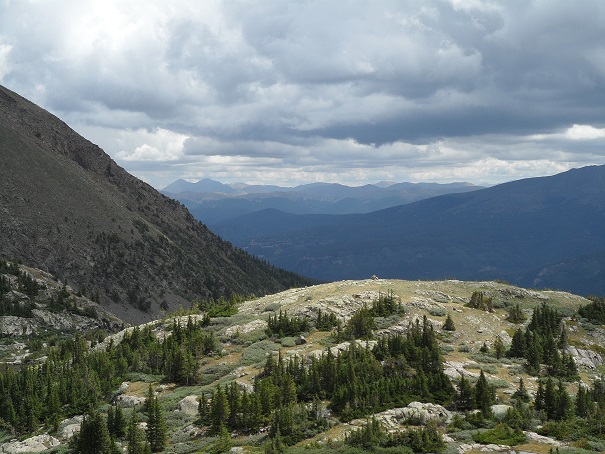
The view from the top of Mohawk Lake, which is a day hike near Breckenridge, Colorado.
Setting out on a day of hiking is a relaxing way to escape from the daily stress of life. This stress, however, can follow hikers if they fail to effectively plan for their adventure, leaving them away from civilization without the necessary supplies. While planning for a day hike, check out our list of packing supplies.
1. Water: This is by far the most important thing someone can bring on a hike. Simply remembering to pack water is not enough, but rather knowing how much to pack is. It is not uncommon for someone to get halfway through a day hike only to realize they failed to understand how much they would actually drink. Most of us come up short in regard to the daily requirements for H2O, but when your body is actually working hard, it needs the full amount, if not more.
To plan accordingly, map your trip to see how long it will take. For specific information about how much water one should take on a hike, check out this advice from Section Hiker. It is typically recommended to bring three to four liters on a long day hike. For these longer trips, hikers may want to carry a small- to medium-sized pack that can either store the water easily or choose one that comes with a built-in hydration system. Having to carry the extra weight of water is worth ensuring there will be enough throughout the hike’s entirety. A water purifier will most likely not be needed for a day hike, but packing one never hurts.
2. Hiking shoes: While wearing hiking shoes may be an obvious decision, many people choose to hike regardless if they are wearing proper shoes. Day hikes are popular for not only outdoor enthusiasts, but vacationers who typically don’t spend as much time outside. This means a lot of people are lacking the proper footwear and may not want to invest the money in an expensive pair of hiking boots. A lot of people will regret this decision once out on the trail when they are lacking the support provided by a meant-for-hiking shoe. These do not have to be expensive purchases, as there are plenty of hiking shoes that come at a reasonable cost. Also, many newer hiking shoes meant for day hiking on light trails resemble more of a sneaker and can be great for day-to-day use as well as on the trail.
If you’re feeling overwhelmed about all of the hiking shoe options out there, check out REI’s advice for how to choose the right shoe.
3. Clothing: Deciding which clothing to wear on a day hike is completely dependent on the hike’s location and expected weather, but typically a pair of hiking shorts or pants paired with a light, breathable T-shirt or tank top is a good option. Choosing the right fabric is key, so look for brands that market clothing as breathable, sweat-proof materials that dry quickly.
If the hike is going to include a somewhat large increase in altitude, make sure to pack a jacket or sweatshirt that is light but well insulated, so as to not take up too much room in your pack. Sometimes a light track jacket that has a rain shell is a good option because of the variety of weather conditions it can endure. Another must-pack item is an extra pair of socks. If there rain, streams, or lakes may be encountered, it’s better to have a back-up pair. Having a hat and a pair of sunglasses on-hand is also helpful when hiking in direct sunlight.
4. Food: Also probably a given, food is one of the most important things to pack on a day hike. Take into account how many hours you will be gone and then overcompensate. Having too much food is better than not having enough while you’re in the middle of the wilderness. Keep in mind that your body will constantly be working and therefore you will need to consume more calories from food that keeps your body going rather than those that slow you down.
Packs with built-in coolers are fantastic for day hikes, as they keep the food cold enough for just the right amount of time. By the time you return from your hike is when the cooler stops being effective in most cases. While sandwiches seem like a good meal to have on the trail, they may be crushed in your pack. Try replacing the soft bread with a wrap, and fill it with your preferred ingredients. Hard fruits and vegetables are great on-hand snacks, as well as energy and protein bars.
5. First aid kit: To many, a first aid kit may seem unnecessary on such a short hike, but packing one and carrying the extra weight is, once again, better than being without one. In additional to the typical bandages, gauze, and adhesive tape, make sure to purchase one (or build your own) that includes pain relievers and other medications, a Swiss Army Knife, antihistamine, and antibiotic ointment. Pack additional supplies based on your personal needs as well as understanding the details of your trip.
Image courtesy Heather Kucma

 Your Privacy Choices
Your Privacy Choices
 The
The